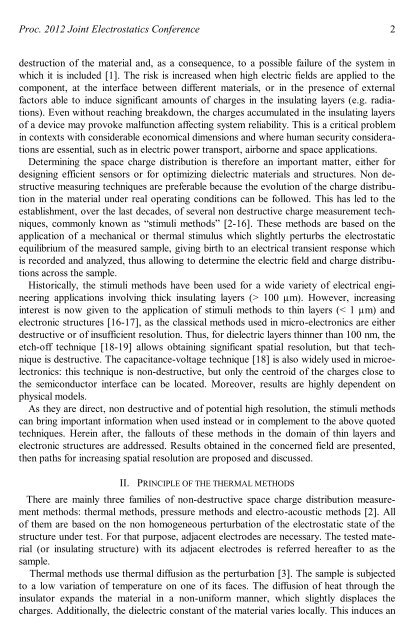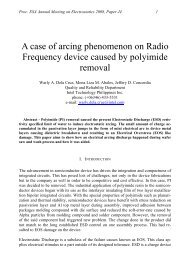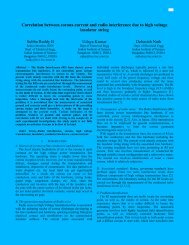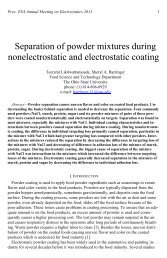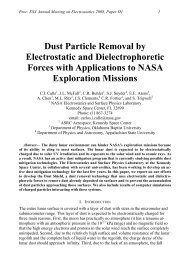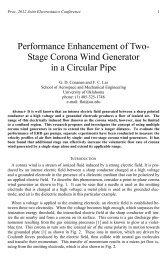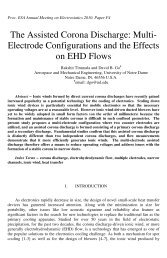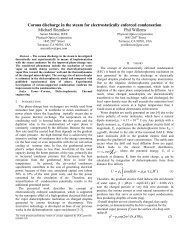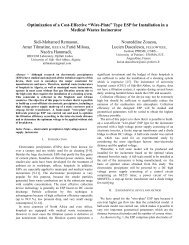Toward non destructive high resolution thermal methods for electric ...
Toward non destructive high resolution thermal methods for electric ...
Toward non destructive high resolution thermal methods for electric ...
You also want an ePaper? Increase the reach of your titles
YUMPU automatically turns print PDFs into web optimized ePapers that Google loves.
Proc. 2012 Joint Electrostatics Conference 2destruction of the material and, as a consequence, to a possible failure of the system inwhich it is included [1]. The risk is increased when <strong>high</strong> <strong>electric</strong> fields are applied to thecomponent, at the interface between different materials, or in the presence of externalfactors able to induce significant amounts of charges in the insulating layers (e.g. radiations).Even without reaching breakdown, the charges accumulated in the insulating layersof a device may provoke malfunction affecting system reliability. This is a critical problemin contexts with considerable economical dimensions and where human security considerationsare essential, such as in <strong>electric</strong> power transport, airborne and space applications.Determining the space charge distribution is there<strong>for</strong>e an important matter, either <strong>for</strong>designing efficient sensors or <strong>for</strong> optimizing di<strong>electric</strong> materials and structures. Non <strong>destructive</strong>measuring techniques are preferable because the evolution of the charge distributionin the material under real operating conditions can be followed. This has led to theestablishment, over the last decades, of several <strong>non</strong> <strong>destructive</strong> charge measurement techniques,commonly known as “stimuli <strong>methods</strong>” [2-16]. These <strong>methods</strong> are based on theapplication of a mechanical or <strong>thermal</strong> stimulus which slightly perturbs the electrostaticequilibrium of the measured sample, giving birth to an <strong>electric</strong>al transient response whichis recorded and analyzed, thus allowing to determine the <strong>electric</strong> field and charge distributionsacross the sample.Historically, the stimuli <strong>methods</strong> have been used <strong>for</strong> a wide variety of <strong>electric</strong>al engineeringapplications involving thick insulating layers (> 100 µm). However, increasinginterest is now given to the application of stimuli <strong>methods</strong> to thin layers (< 1 µm) andelectronic structures [16-17], as the classical <strong>methods</strong> used in micro-electronics are either<strong>destructive</strong> or of insufficient <strong>resolution</strong>. Thus, <strong>for</strong> di<strong>electric</strong> layers thinner than 100 nm, theetch-off technique [18-19] allows obtaining significant spatial <strong>resolution</strong>, but that techniqueis <strong>destructive</strong>. The capacitance-voltage technique [18] is also widely used in microelectronics:this technique is <strong>non</strong>-<strong>destructive</strong>, but only the centroid of the charges close tothe semiconductor interface can be located. Moreover, results are <strong>high</strong>ly dependent onphysical models.As they are direct, <strong>non</strong> <strong>destructive</strong> and of potential <strong>high</strong> <strong>resolution</strong>, the stimuli <strong>methods</strong>can bring important in<strong>for</strong>mation when used instead or in complement to the above quotedtechniques. Herein after, the fallouts of these <strong>methods</strong> in the domain of thin layers andelectronic structures are addressed. Results obtained in the concerned field are presented,then paths <strong>for</strong> increasing spatial <strong>resolution</strong> are proposed and discussed.II. PRINCIPLE OF THE THERMAL METHODSThere are mainly three families of <strong>non</strong>-<strong>destructive</strong> space charge distribution measurement<strong>methods</strong>: <strong>thermal</strong> <strong>methods</strong>, pressure <strong>methods</strong> and electro-acoustic <strong>methods</strong> [2]. Allof them are based on the <strong>non</strong> homogeneous perturbation of the electrostatic state of thestructure under test. For that purpose, adjacent electrodes are necessary. The tested material(or insulating structure) with its adjacent electrodes is referred hereafter to as thesample.Thermal <strong>methods</strong> use <strong>thermal</strong> diffusion as the perturbation [3]. The sample is subjectedto a low variation of temperature on one of its faces. The diffusion of heat through theinsulator expands the material in a <strong>non</strong>-uni<strong>for</strong>m manner, which slightly displaces thecharges. Additionally, the di<strong>electric</strong> constant of the material varies locally. This induces an


